
The Dilwara Temples or Delvada Temples are a group of Śvētāmbara Jain temples located about 2+1⁄2 kilometres from the Mount Abu settlement in Sirohi District, Rajasthan's only hill station. The earliest were built by Bhima I and supposedly designed or at least financed by Vastupala, Jain minister of Dholka. They date between the 11th and 16th centuries, forming some of the most famous monuments in the style of Māru-Gurjara architecture, famous for their use of a very pure white marble and intricate marble carvings. They are managed by Seth Shri Kalyanji Anandji Pedhi, Sirohi and are a pilgrimage place for Jains, and a significant general tourist attraction. The Dilwara temples are regarded as the most impressive among Jain temples in Rajasthan.

Jaisalmerpronunciation (help·info), nicknamed "The Golden city", is a city in the Indian state of Rajasthan, located 575 kilometres (357 mi) west of the state capital Jaipur. The town stands on a ridge of yellowish sandstone and is crowned by the ancient Jaisalmer Fort. This fort contains a royal palace and several ornate Jain temples. Many of the houses and temples of both the fort and of the town below are built of finely sculptured sandstone. The town lies in the heart of the Thar Desert and has a population, including the residents of the fort, of about 78,000. It is the administrative headquarters of Jaisalmer District. Jaisalmer was once the capital of Jaisalmer State.

Shikharji, also known as Sammed or Sammet Shikharji, is one of the Holiest pilgrimage sites for Jains, in Giridih district, Jharkhand. It is located on Parasnath hill, the highest mountain in the state of Jharkhand. It is the most important Jain Tirtha, for it is the place where twenty of the twenty-four Jain tirthankaras along with many other monks attained Moksha. It is one of the five principal pilgrimage destinations along with Girnar, Pawapuri, Champapuri, Dilwara, Palitana and Ashtapad Kailash.

Rajasthan, a state in western India, has had a close historical connection with Jainism. Southwestern Rajasthan was the main centre for Svetambara Jainism. Major Digambara centres are in the northern and eastern parts of Rajasthan. Central and Northern Rajasthan are the main centres for the Terapanth sect of Svetambara Jainism.

Jaisalmer Fort is situated in the city of Jaisalmer, in the Indian state of Rajasthan. It is believed to be one of the very few "living forts" in the world, as nearly one fourth of the old city's population still resides within the fort. For the better part of its 860-year history, the fort was the city of Jaisalmer. The first settlements outside the fort walls, to accommodate the growing population of Jaisalmer, are said to have come up in the 17th century.
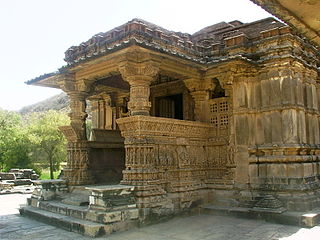
The architecture of the Indian state of Rajasthan has usually been a regional variant of the style of Indian architecture prevailing in north India at the time. Rajasthan is especially notable for the forts and palaces of the many Rajput rulers, which are popular tourist attractions.
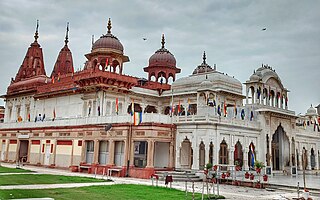
Shri Mahavir Ji is an important and prominent Jain pilgrimage site situated in Shri Mahaveerji town in Hindaun Block, Karauli district in Rajasthan. Given the importance of the religious place, the Indian Railways has specifically developed a railway station under West Central Railway zone by the name of Shri Mahaveerji railway station which is 10 minutes drive from the temple and temple authorities have arranged for regular buses from the station to the temple. The temple is visited by millions of Jain and Hindu devotees every year.

Rajasthan is one of the most popular tourist destinations in India, for both domestic and international tourists. Rajasthan attracts tourists for its historical forts, palaces, art and culture with its slogan "Padharo Mhare Desh". Jaipur, is also known as Pink City, is a very popular tourist destination, being the capital of Rajasthan and a part of the Golden Triangle. The Walled City of Jaipur is a UNESCO World Heritage Site and is only the second Indian city to be recognized, after Ahmedabad.
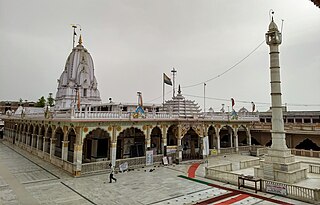
Tijara Jain Temple is a digambar Jain temple dedicated to Chandraprabha. The temple is located in the hill town Tijara, in the Alwar district of Rajasthan, India. It is an Atishaya Kshetra. It is 55 kilometres (34 mi) from Alwar and 110 kilometres (68 mi) from Delhi. The location is a tirtha for the Jains and a tourist attraction.

Lodrawa is a village in Jaisalmer district, Rajasthan, India. It is located 15 kilometers to the north-west of Jaisalmer. Lodrawa was the ancient capital of the Bhati dynasty until Rawal Jaisal founded the Jaisalmer state and moved the capital to Jaisalmer in 1156 CE.

Ranakpur Jain temple or Chaturmukha Dharana Vihara is a Śvētāmbara Jain temple at Ranakpur dedicated to Tirthankara Rishabhanatha. The temple is located in a village of Ranakpur near Sadri town in the Pali district of Rajasthan.
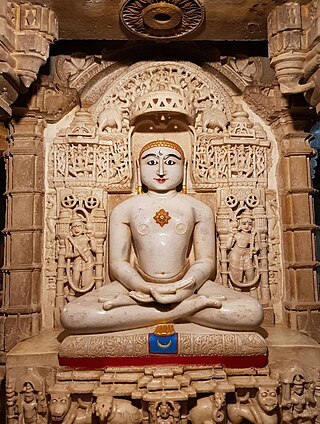
Chandraprabha or Chandranatha is the eighth Tirthankara of Tīrthaṅkara of Jainism in the present age. According to traditional accounts, he was born to King Mahasena and Queen Lakshmana Devi at Chandrapuri to the Ikshvaku dynasty. According to Jain texts, his birth-date was the twelfth day of the Posh Krishna month of the Indian calendar. He is said to have become a siddha, a liberated soul which has destroyed all of its karma.
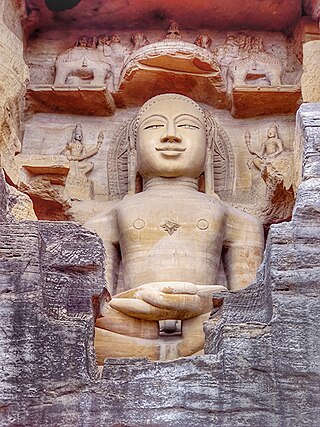
The Gopachal rock-cut Jain monuments, also called Gopachal Parvat Jaina monuments, are a group of Jain rock-cut carvings dated to between the 7th and 15th centuries. They are located around the walls of the Gwalior Fort, Madhya Pradesh. They depict Tirthankaras in seated Padmasana posture as well as standing Kayotsarga posture, in the typical naked form of Jain iconography.

Siddhachal Caves are Jain cave monuments and statues carved into the rock face inside the Urvashi valley of the Gwalior Fort in northern Madhya Pradesh, India. There are the most visited among the five groups of Jain rock carvings on the Gwalior Fort hill. They were built over time starting in the 7th-century, but most are dated to the 15th-century CE. Many of the statues were defaced and destroyed under the orders of the Muslim Emperor Babur of the Mughal dynasty in the 16th century, while a few repaired and restored after the fall of the Mughal dynasty and through the late 19th century.
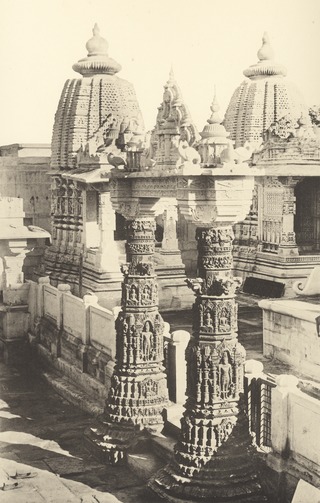
The Mahavira Jain temple is built in Osian of Jodhpur District, Rajasthan. The temple is an important pilgrimage of the Oswal Jain community. This temple is the oldest surviving Jain temple in Western India and was built during the reign of Mahārāja Śrī Vatsarāja of Imperial Pratihāras. The temple is visited by both Jain and Hindu.

The Kumbharia Jain temples is a group of five Jain temples in the Kumbhariya, Banaskantha district in Gujarat, India. Constructed from 1062 to 1231 CE during the reign of the Chaulukya dynasty, they are noted for their elaborate architecture.

Lodhurva Jain temple is a Jain temple in the Lodhruva village of Jaisalmer district in Rajasthan.

Kamal Basadi is a Jain temple located inside Belgaum Fort in city of Belgaum, Karnataka.

Shobhnath temple is an ancient Jain temple located in the Shravasti city of Uttar Pradesh.
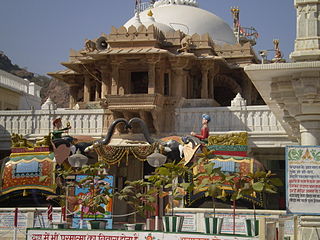
Nakodaji Tirth is a major Jain tirth in the Indian state of Rajasthan, located between the villages of Vikrampura and Nakoda in Barmer District.




























